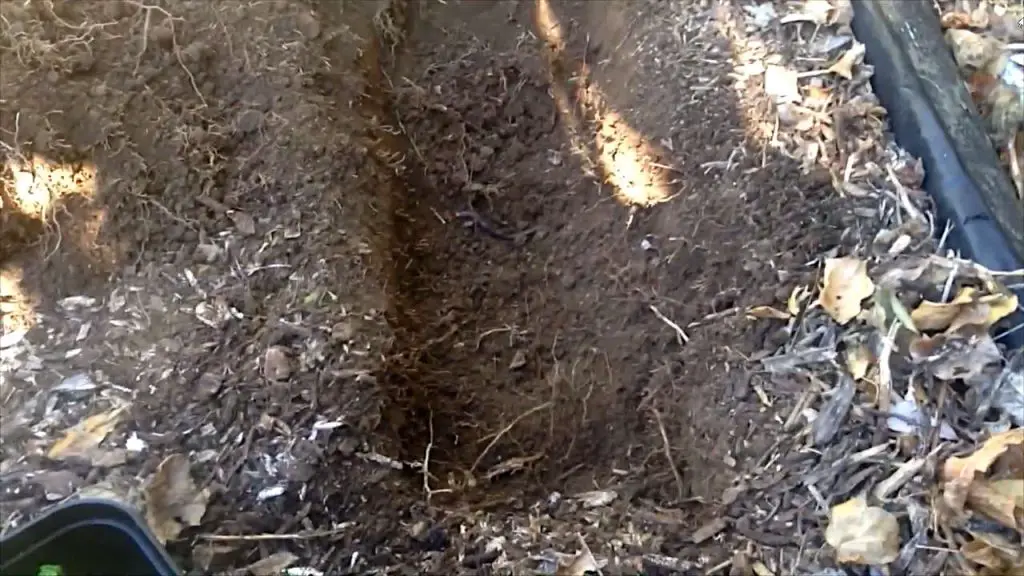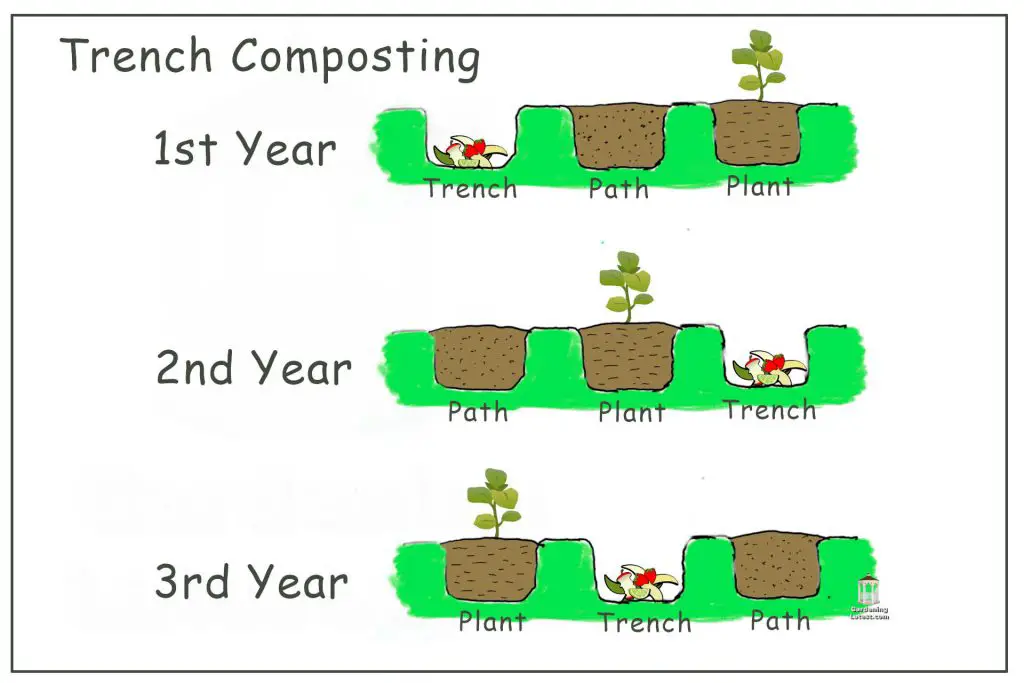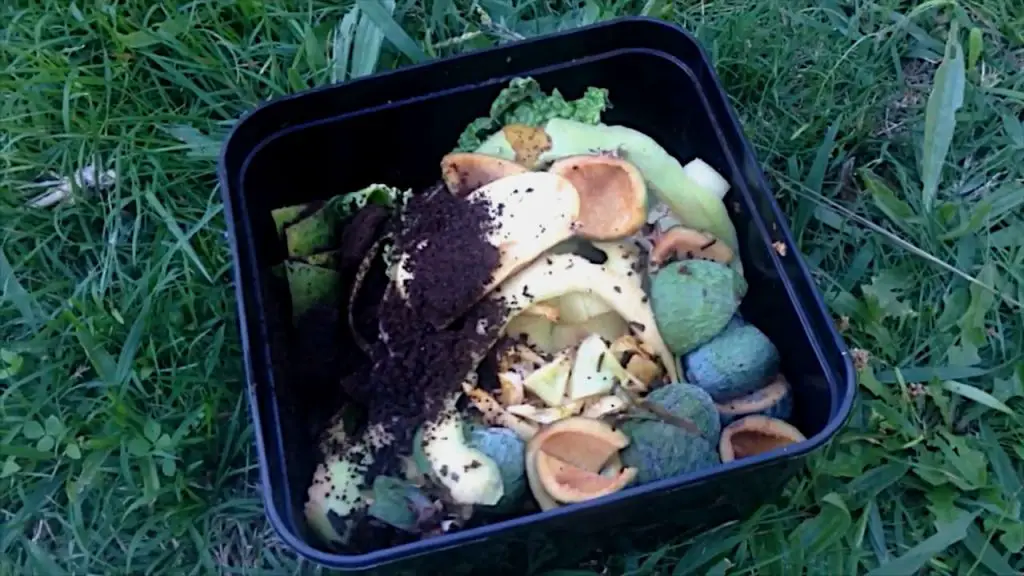Trench Composting | Gardening Alchemy
What Is Trench Composting?
As a process, trench composting results in the creation of moisture-retentive, nutrient-rich soil, which reduces the requirement for non-organic fertilizers. The process stimulates the growth of microorganisms and fungus, which are responsible for the decomposition of organic materials and the creation of finished compost (humus), as well as helping to develop and maintain the soil’s ecosystem.
Trench composting is a highly efficient method of composting that utilizes the natural heat of the sun to break down organic materials quickly. (see our guide to composting at home).
The process is much loved by organic gardeners as it is one of the most effective ways of eliminating the need for the use of non-organic materials in the growing process.
Fundamentals of Trench Composting
Trench composting entails digging long narrow trenches (each trench about 2 feet wide, 5-7 feet long, and 2-3 feet deep). As materials break down, they are placed in the trenches and then covered with soil, leaves, and compost. To speed up decomposition, you can add a shovelful of compost every 30-60 days.
How to Trench Compost
There are several different ways to trench compost. Which way you choose will depend on largely the size and shape of your yard. A lot of gardeners build out a series of trenches. On to four trenches running parallel, planed out for their upcoming planting. Other gardeners will build a long continuous trench or add a further length to an existing trench. You can adapt the system to suit your specific requirements. You could dig your trench in a semi-circle if that is part of your landscape design.
Step One: Trench Compost Depth

Using a fork and spade dig a trench about 2 feet wide, 5-7 feet long, and 2-3 feet deep.
Step Two: Add Organic Material
Add your green (vegetable scraps) and brown materials ( leaves, grass cuttings, and other minor prunings) into the trench. Try to spread them out evenly at the bottom of the trench.
Step Three : Cover Over
Cover over the composting materials with the soil that you originally removed when digging the trench. You can add some mulch, and wet shredded cardboard before replacing the soil. The moisture in the mulch will help speed up the breakdown of the green and brown composting materials.
Step Four: How long does trench composting take?

Trench composting is anaerobic and is a variation of the cold composting technique. The process will usually take around three to four months before the material breaks down. In general, it is advised that you don’t plant on top for a year to give ample time for the material to break down in full and begin providing nutrients to the soil.
Trench Rotation

Due to the extended timeframe before being able to plant many gardeners employ a rotation process. They divide their garden into three sections. They create trenches in the first section and the next year plant on this while digging a new trench in the second section for the following year and so on.
They then rotate between these sections re-digging the trenches in each section on a two-year cycle. Each trench serves a dual purpose for two out of every three years, acting either as a walkway or a compost trench while in the third year it is planted on.
Accelerating the Trench Composting Process
It is possible to speed up the trench composting process by fermenting in advance the nitrogen-rich food scraps that are going to be part of the organic material going into the trench.
Trench composting, being an anaerobic process, works without oxygen as in fermentation. As such we can help accelerate the process by fermenting the food scraps in advance of burying them. The fermentation method is used as part of the bokashi composting process. This is achieved by adding an activator to the food scraps and leaving them in an airtight bucket. Many composters use a bokashi ingredient as the activator but yeast spores and lactic acid bacteria work well too.
The process takes a couple of weeks with the scarps essentially still looking the same, although there is a distinct smell. What has happened is that the food scraps have been infused with microorganisms. Once these are buried in the ground they rapidly decompose.
Trench composting on raised beds
Trench composting can easily be adapted to work on raided beds. The important thing with your raised beds is to build them deep enough for the trench. However, you will have less depth to work with so your trench is likely to be shallower.
As such you may want to speed up the decomposition process. You can do this by adding an activator. You can buy an activator for your garden center but you can also create your own. One method is to add already finished compost into your composting materials, The bacteria present in the finished compost will help kick-start the decomposition process.
Another accelerator is urine is particularly good. It contains high amounts of ammonia (which includes nitrogen) and phosphorus, as well as other chemical-rich elements that not only speed up the decomposition process but also help feed plants!
What Materials you Can’t Compost with Trench Composting?
As with cold composting and to some extent hot composting there are certain materials that you should not compost using the trench composting method.
The main ones are meat and dairy products. Although they actually produce excellent compost they attract vermin and the stench produced whilst decomposing can be very strong. In terms of organic materials don’t compost diseased or fungus-infected plants. The process is unlikely to completely destroy the pathogens and these could reinfect your new plantings.
Another area to be careful with is packaging marked ‘compostable’. This actually means commercially compostable. You can, however, compost packaging marked home compostable. You can find a comprehensive list of what you can and can’t compost here to make sure you get it right.
When can you start trench composting?

Trench composting can be conducted pretty much any time of year, although if the ground freezes it might be difficult to dig a trench. If you do expect heavy freezing conditions then you can insulate the bottom of the trench using cardboard, and make sure you cover over the surface with a tarpaulin
The ideal time to start a compost trench would be in the late Fall when you have the maximum amount of organic material available.
Once made the trench can work its magic over the winter months being ready for you to start planting in early Spring.
Pros of Trench Composting
- Good for small gardens or spaces as traditional compost piles can take up quite a bit of space.
- You can compost large quantities of organic material and food waste
- Efficient composting
- Can be used all year round, even in the winter months
- Can be used on raised beds
- An environmentally sound way to dispose of your kitchen scraps and organic waste.
- The compost is already in place for planting. You don’t have to move it from a compost pile to the area you want to apply the compost.
Cons of Trench Composting
There are hardly any real cons. Yes, it is much slower than hot composting but if you have planned out your planting and garden schedule then this should not be an issue.
The other possible problem is vermin, especially if there aren’t enough covers. You should cover the trench with boards to prevent them from digging into it. Cold composting doesn’t always work, so you should add weeds to the trench.
Final Thoughts | Trench Composting
There are more advantages to trench composting than disadvantages. However, trench composting can be hard work. You need to dig deep holes and then fill them up again. This takes time and effort. But if you want to improve the quality of your soil, this is the way to go. The upside is that You’ll get better results by using trench composting than by using top dressing.
Ultimately, trench composting is an effective gardening technique. Yes, it requires digging trenches every year, but it keeps the soil moist and improves drainage. You should definitely consider the process if you want to grow healthy crops.
